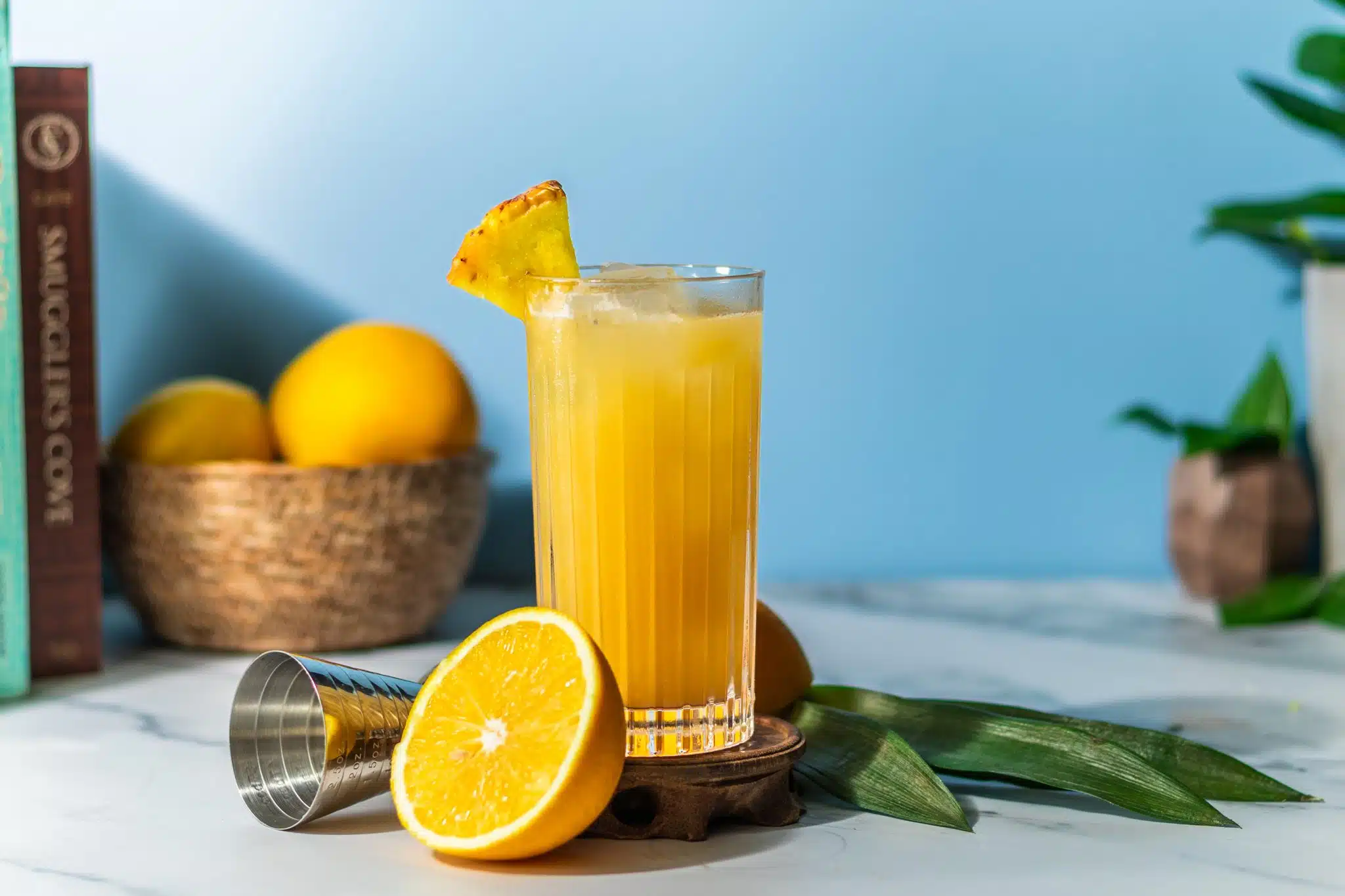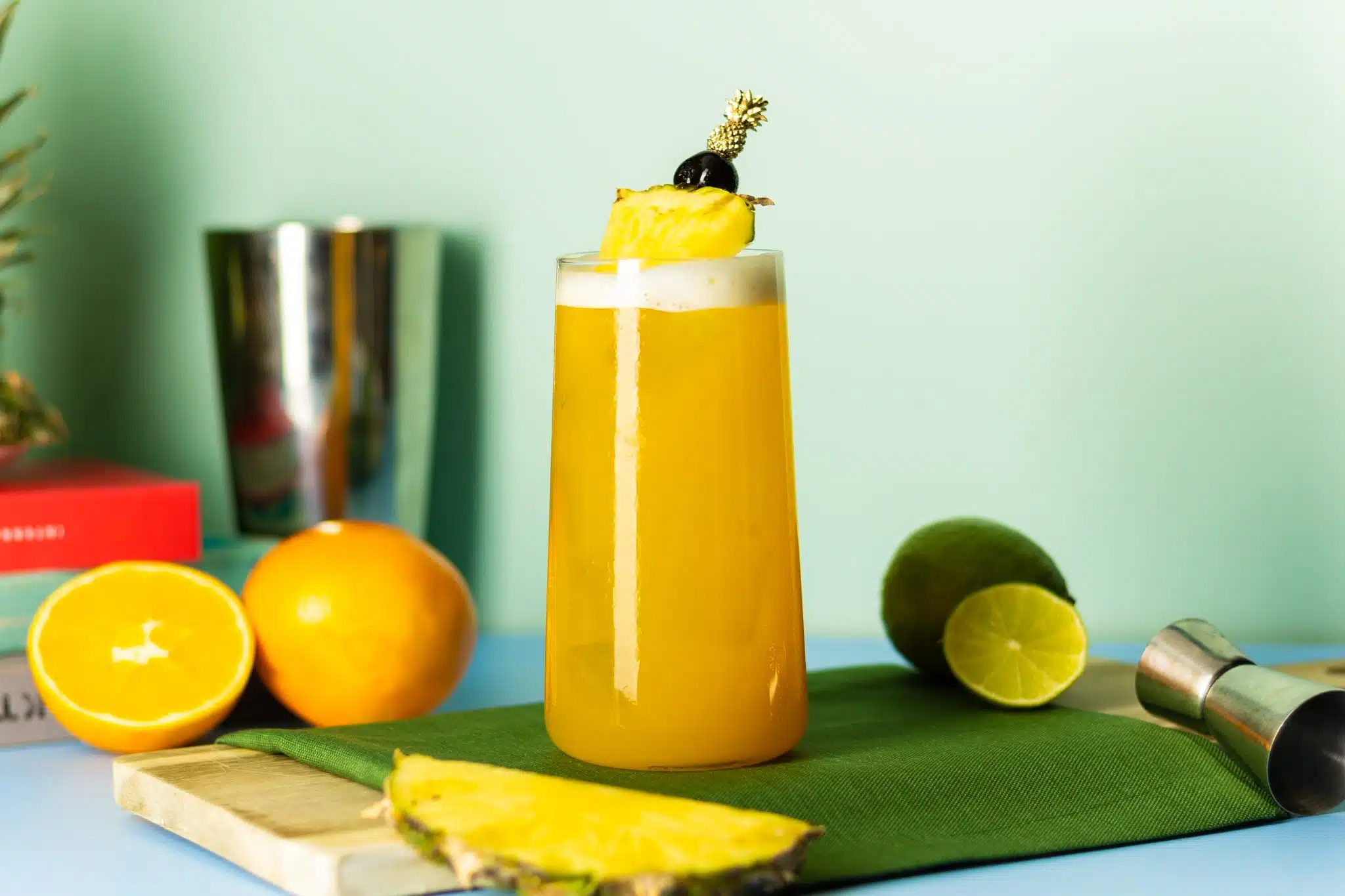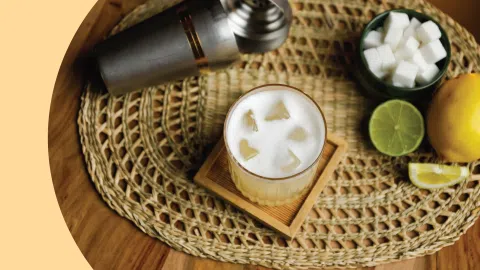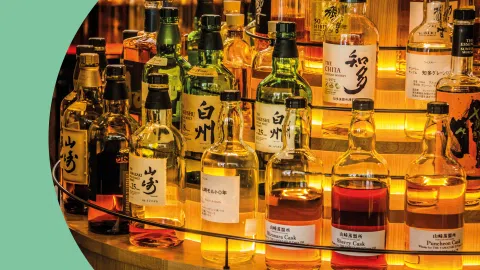Tiki cocktails are a category of mixed drinks inspired by Polynesian culture, tropical flavors, and exotic aesthetics.
These drinks were popularized in the mid-20th century and closely associated with the Tiki movement, which includes themed bars, restaurants, and a distinct style of decor characterized by bamboo, carved idols, and tropical motifs.
The key to a great Tiki cocktail is the blend of flavors—rum, citrus, tropical fruits, and rich syrups like orgeat or falernum. From a classic Mai Tai to the powerful Zombie, each Tiki cocktail brings a burst of tropical delight.
The History of Tiki Culture and Cocktails
The origins of Tiki culture and cocktails can be traced back to the 1930s, when Don the Beachcomber, a.k.a. Donn Beach, opened the first Tiki bar in Hollywood. Donn had traveled extensively in the Caribbean and the South Pacific, and he brought back not only rum but also the island-inspired décor that would become the hallmark of Tiki bars. His bar was a mix of Polynesian themes, tropical ingredients, and, of course, rum-based cocktails.
Not long after, Trader Vic (Victor Bergeron) opened his own Tiki bar in Oakland, and the competition between these two icons helped solidify Tiki cocktails as a staple of American drinking culture. While their drinks were inspired by the tropics, the flavors were a mix of Caribbean rum traditions, Polynesian aesthetics, and American cocktail innovation.
After World War II, Tiki culture exploded in the U.S. People were eager for escapism, and Tiki bars provided that perfect blend of fantasy, fun, and flavorful drinks. The Tiki craze reached its peak in the 1950s and 60s, when every major city had at least one Tiki bar, complete with bamboo furniture, carved totems, and flaming cocktails.

Essential Elements of a Tiki Cocktail
What makes a Tiki cocktail different from a regular rum drink? It’s all in the layers of flavor. A true Tiki cocktail balances sweetness, spice, sourness, and a bit of bitterness. Here’s a breakdown of the key components that go into these iconic drinks:
-
The Base Spirits
While rum is the king of Tiki cocktails, it’s not the only spirit that gets featured. Tiki drinks often blend multiple types of rum—light, dark, aged, and even overproof rums—to create depth and complexity. But you’ll also find other spirits making appearances, including:
- Gin: Adds botanical complexity.
- Brandy: Adds richness to cocktails like the Fog Cutter.
- Bourbon: Adds a warm, robust character to some modern Tiki variations.
We have more Rum Drinks on Drinksworld: Spiced Rum Drinks – Dark Rum Drinks – White Rum Drinks – Gold Rum Drinks
-
Fruit Juices
Tiki cocktails are known for their use of fresh fruit juices, which balance the strong flavors of the spirits. The classics include:
- Pineapple juice: Sweet, tangy, and a Tiki staple.
- Lime juice: Adds essential tartness to balance the sweetness.
- Orange juice: Provides a smooth, bright citrus flavor.
- Passion fruit juice: A tropical twist with both sweetness and tang.
More fruit juice cocktails on Drinksworld: Pomegranate Cocktails – Cranberry Cocktails – Grapefruit Cocktails
-
Syrups and Sweeteners
To balance the strong flavors of rum and citrus, Tiki cocktails often use rich, flavorful syrups:
- Orgeat syrup: A sweet almond syrup that’s essential in drinks like the Mai Tai.
- Falernum: A spiced syrup with flavors of cloves, ginger, and lime.
- Honey syrup: Adds a natural sweetness to drinks like the Navy Grog.
- Grenadine: Used for a touch of color and sweetness.
-
Spices and Bitters
Tiki cocktails often include spices to enhance the tropical flavors. Common additions include:
- Cinnamon: Adds warmth and depth.
- Nutmeg: Often sprinkled on top for aroma.
- Allspice dram: A spiced liqueur with clove and cinnamon notes.
- Angostura bitters: Used to add complexity and balance sweetness.
-
Garnishes and Presentation
Tiki drinks are as much about the presentation as they are about the flavors. A great Tiki cocktail often comes with elaborate garnishes:
- Pineapple wedges, leaves, or spears.
- Orchids or edible flowers.
- Paper umbrellas and swizzle sticks.
- Flaming lime shells: A show-stopping garnish where overproof rum is poured into a lime half and set on fire.
The glassware also plays a role in the Tiki experience, with drinks often served in carved mugs that resemble island totems or animals like parrots and sharks. The more elaborate, the better!
Classic Tiki Cocktails You Need to Know
Now, let’s get into the drinks that define the Tiki genre. These are the classics that have stood the test of time, each with its own unique story and flavor profile.
Arguably the most famous Tiki cocktail, the Mai Tai was created by Trader Vic in the 1940s. Made with a blend of rum, lime juice, orgeat syrup, and orange liqueur, the Mai Tai is a perfectly balanced cocktail that embodies Tiki. Its name comes from the Tahitian phrase “Maita’i roa ae,” meaning “Out of this world!”
Created by Donn Beach, the Zombie is not for the faint-hearted. This potent cocktail is made with rum, apricot brandy, lime juice, orange juice, pineapple juice, bitters, and a touch of grenadine. Donn originally limited customers to two Zombies per visit—because, as the story goes, the drink could “turn you into a zombie” if you weren’t careful!
A Tiki staple that blends three types of rum (light, dark, and overproof), Navy Grog is sweetened with honey syrup and balanced with lime and grapefruit juices. It’s topped with a sprig of mint and sometimes served with a rum-soaked ice cone.

The Scorpion is a large-format Tiki cocktail, often served in a communal bowl with long straws. It’s made with rum, brandy, orange juice, lime juice, and orgeat syrup. This drink is all about balance—citrus and sweetness combined with the richness of the rum and brandy.

Invented in the 1970s at the Soggy Dollar Bar in the British Virgin Islands, the Painkiller is a creamy, tropical drink made with rum, pineapple juice, orange juice, and coconut cream. It’s a smooth, rich cocktail that’s both refreshing and indulgent.
Modern Twists on Tiki Cocktails
While the classics are essential, modern bartenders have been experimenting with Tiki cocktails, putting their own spin on the tropical tradition. Here are a few modern twists to try:
- Mezcal Mai Tai
Swap out the rum for smoky mezcal, and you’ve got a whole new take on the Mai Tai. The mezcal adds a rich, earthy complexity that contrasts beautifully with the sweetness of the orgeat and orange liqueur.
- Gin Zombie
Replace one of the rums in the classic Zombie with gin for a more botanical twist. The gin’s floral notes bring a new layer of complexity to the drink, while the lime and falernum keep it firmly in Tiki territory.
- Tropical Negroni
The classic Negroni gets a Tiki twist by replacing the gin with rum and adding pineapple juice. The bitterness of the Campari pairs surprisingly well with the sweetness of the pineapple and the richness of the rum.
Tiki Techniques: How to Master the Perfect Tiki Cocktail
Creating a perfect Tiki cocktail requires a bit of technique. Here are a few tips to ensure your drinks come out as good as those served at a Tiki bar:
- Use Fresh Ingredients: Always use fresh citrus juices for the best flavor.
- Don’t Skimp on the Ice: Tiki cocktails are best served cold, so use plenty of ice. Crushed ice works particularly well, as it helps dilute the strong flavors over time.
- Layer Flavors: Tiki cocktails are all about balance. Use different types of rum and syrups to create depth and complexity.
- Shake Vigorously: A good Tiki cocktail should be shaken thoroughly to blend all the ingredients and ensure the perfect balance.
Tiki Cocktails for Different Occasions
They are incredibly versatile and suited for any occasion. From small summer gatherings to large beach parties, there’s a Tiki drink to fit every setting:
- Summer BBQs: For a casual backyard BBQ, serve up classics like the Mai Tai or the Painkiller. These drinks are light, refreshing, and easy to sip while grilling.
- Group Gatherings: Tiki drinks like the Scorpion Bowl or Volcano Bowl are perfect for sharing. These large-format cocktails are served in a communal bowl with multiple straws, making them great for entertaining.
- Winter Escapes: Tiki cocktails aren’t just for the summer. A Navy Grog or Hot Buttered Rum can warm you up during the colder months while still delivering those tropical vibes.
- Tiki-Themed Parties: Hosting a Tiki-themed party? Deck out your space with palm leaves, string lights, and bamboo décor. Serve a variety of Tiki cocktails, from the classic Zombie to modern twists like a Mezcal Mai Tai, and encourage guests to wear Hawaiian shirts or leis to set the mood.

How to Make the Perfect Tiki Cocktail at Home
Creating a Tiki cocktail at home may seem like an elaborate process, but it’s easier than you think once you have the right ingredients and tools. Here’s a general guide:
- Gather Your Ingredients: Start with quality rum (or other spirits), fresh fruit juice (pineapple, lime, orange), and syrups (orgeat, falernum, simple syrup).
- Use Fresh Citrus: Always opt for freshly squeezed lime or lemon juice—it makes a huge difference in flavor.
- Shake Vigorously: Most Tiki cocktails are shaken to ensure the flavors are fully mixed and chilled. Add ice and shake for 15-20 seconds.
- Use Crushed Ice: Crushed ice melts faster and helps dilute the strong flavors in Tiki cocktails. It also adds texture to the drink.
- Garnish Generously: Don’t skimp on the garnishes. A sprig of mint, pineapple leaves, or even a flaming lime shell can elevate your Tiki cocktail from good to great.
If you’re feeling adventurous, try making a classic like the Mai Tai or mix up a batch of Rum Punch for a crowd.
Tiki Bars and the Culture Behind Them
Tiki culture is about more than just the cocktails—it’s the entire atmosphere that makes it special. In the mid-20th century, Tiki bars became cultural icons, offering guests a total escape from the ordinary. Stepping into a Tiki bar felt like entering a tropical paradise, with dim lighting, bamboo décor, carved totems, and island-inspired music filling the air.

Legendary spots like Trader Vic’s and Don the Beachcomber were designed to transport visitors to an exotic world. These bars were filled with Polynesian-inspired decorations, seashells, waterfalls, and sometimes even live parrots.
Although Tiki’s popularity waned in the 1970s, the early 2000s saw a revival. New bars and restaurants embraced the Tiki vibe once again, blending traditional island aesthetics with modern craft cocktails. Today, places like Smuggler’s Cove in San Francisco and Three Dots and a Dash in Chicago are leading the charge, bringing the classic Tiki experience to a new generation of cocktail lovers.
FAQs
What are tiki cocktails?
Tiki cocktails are tropical, rum-based drinks that originated in the 1930s and are known for their exotic flavors, bold presentations, and elaborate garnishes. They typically blend multiple types of rum, fresh fruit juices (like pineapple, lime, and orange), syrups (such as orgeat and grenadine), and spices like cinnamon or nutmeg. These cocktails are served in decorative mugs or glasses and are designed to evoke a sense of island escapism and fun.
What is the difference between a Tiki cocktail and a regular rum cocktail?
Tiki cocktails are distinguished by their complex layers of flavors, often blending multiple types of rum, fresh fruit juices, syrups, and spices. They also have a distinct tropical presentation with elaborate garnishes.
Why are Tiki cocktails served in exotic mugs?
The tradition of serving Tiki cocktails in ceramic mugs or bowls comes from the desire to enhance the drink’s exotic, escapist experience. The elaborate presentation is part of the fun and mystique of Tiki culture.
Can you make Tiki cocktails without rum?
Absolutely! While rum is traditional, Tiki cocktails can be made with a variety of spirits, including gin, tequila, bourbon, or brandy. Modern variations often experiment with different base spirits.
Are Tiki cocktails always tropical and fruity?
While tropical flavors are a hallmark of Tiki cocktails, they’re not all light and fruity. Drinks like the Zombie and Navy Grog pack a serious punch and offer more complex, spiced flavors.








